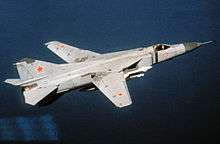1989 Belgian MiG-23 crash
Coordinates: 50°45′33.8″N 3°18′41.4″E / 50.759389°N 3.311500°E
 MiG-23M | |
| Accident summary | |
|---|---|
| Date | 4 July 1989 |
| Summary | Crew bail-out, fuel exhaustion |
| Site | Kortrijk, Belgium |
| Crew | 1 |
| Fatalities | 1 (on ground) |
| Survivors | 1 (crew) |
| Aircraft type | Mikoyan-Gurevich MiG-23 |
| Flight origin | Kołobrzeg, Poland |
The 1989 Belgian MiG-23 crash involved the crash of an unmanned Soviet MiG-23M "Flogger-B" into a house in Kortrijk, Belgium, on 4 July 1989, killing an 18-year-old man.
Overview
The incident started as a routine training flight. Colonel Nikolai Skuridin, the pilot, departed from the Soviet Bagicz Airbase near Kołobrzeg, Poland. During takeoff, the afterburner failed and the engine began losing power. At an altitude of 150 meters and descending, the pilot assumed he had a complete engine failure and ejected without incident. The engine had not failed completely, and the aircraft remained airborne, flying on autopilot in a westerly direction.[1][2] The unmanned aircraft left Polish airspace, crossing into the airspace of East Germany and then West Germany, where it was intercepted by a pair of U.S. Air Force F-15s of the 32d Tactical Fighter Squadron, of the United States Air Forces Europe, stationed at Soesterberg Air Base in the Netherlands.[3] As the MiG-23 crossed into Dutch airspace the F-15 pilots reported the plane having no pilot, radioing "There is definitely no pilot in the plane" and continuing the intercept into Belgian airspace. The escorting F-15s were instructed to down the plane over the North Sea. As the MiG ran out of fuel, it started a slow turn to the south. The French Air Force put armed Mirage fighters on readiness in case the MiG approached French territory. After flying over 900 km (560 mi) the MiG crashed into a house, killing a Belgian teenager.[1]
Political response
The Belgian government made a formal protest to the Soviet Union regarding the lack of notification as to the danger the aircraft posed to the civilian population. Belgian Foreign Minister Mark Eyskens expressed concern that "from the time the MiG-23 was first picked up on NATO radar to the time it crashed more than an hour later, no word of warning came from the Soviet side," and that "there was also a 'notable slowness' on the part of the Soviets in disclosing whether the jet was carrying nuclear or toxic weapons."[2]
The USSR paid $685,000 in compensation to Belgium. Colonel Nikolai Skuridin expressed his condolences to the family of the victim.
See also
References
- 1 2 Incident overview from Eastern Wings
- 1 2 "Belgians Protest to Soviets Over Crash of Derelict MIG". New York Times. 6 July 1989. Retrieved 16 March 2007.
- ↑ Davies, Steve, and Dildy, Doug, "F-15 Eagle Engaged – The World's Most Successful Jet Fighter", Osprey Publishing, Botley, Oxford, UK, 2007, ISBN 978-1-84603-169-4, pages 102–106.
External links
- Graphics of the flight (newspaper Libération, description in French)
- CBS News report synopsis from the Vanderbilt Television News Archive